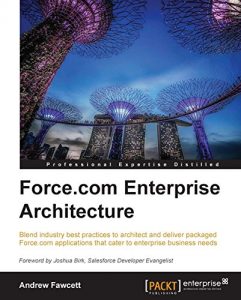About This Book
- Build your own application from start to finish, making use of unique tools and platform features
- Learn how to use the platform to build a truly integrated, scalable, and robustly engineered application to design, develop, package, and support an application focusing on enterprise-level customer demands
- Build the first iteration of your own ready-to-install packaged application with the help of a mix of step-by-step, worked examples and tips and tricks that discuss and answer key architectural questions
Who This Book Is For
This book is for advanced Force.com developers and architects who need to understand the Salesforce platform from the perspective of enterprise-level requirements. You should have an existing understanding of Apex and Visualforce. Those familiar with other enterprise software ecosystems will also find this book ideal as they adopt Force.com.
What You Will Learn
- Learn how to package, install, test, and upgrade an application, and understand how best to license and support an application
- Define architecture-aligning data storage and functional requirements with the platform for a consistent and integrated user experience using the platform’s declarative features
- Develop Apex code that is easy to navigate, self-documenting, testable, robust, and organic leveraging the Separation of Concerns principle
- Leverage your application's client-agnostic Service layer backbone to support numerous platform areas such as Batch, Scheduler, Visualforce, and the latest Salesforce1 client
- Apply querying, indexing and asynchronous best practices, guidelines, and patterns for large data volumes and complex processes covering custom indexes and Batch Apex
- Explore approaches and tips on how to develop advanced application life cycle processes around Source Control, Continuous Integration, and testing, utilizing the Metadata and Tooling APIs from Salesforce
In Detail
Successful enterprise applications require planning, commitment, and investment in understanding the best practices, processes, tools, and features available.
This book will teach you how to architect and support enduring applications for enterprise clients with Salesforce by exploring how to identify architecture needs and design solutions based on industry standard patterns. As your development team grows, managing the development cycle with more robust application life cycle tools and using approaches such as Continuous Integration becomes increasingly important. There are many ways to build solutions on Force.com—this book cuts a logical path through the steps and considerations for building packaged solutions from start to finish, covering all aspects from engineering to getting your application into the hands of your customers, and ensuring that they get the best value possible from your Force.com application.






